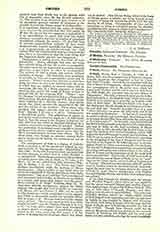

O’Neill, HUGH Earl of Tyrone, b. 1540; d. at Rome, 1616; was the youngest son of Mathew, of questionable parentage, but recognized as heir by Conn, first Earl of Tyrone. As such he was ennobled with the title of Baron of Dungannon. Shane O’Neill contested this arrangement and in the petty wars which followed both Mathew and his eldest son lost their lives. In 1562 Hugh, the youngest son, became Baron of Dungannon. His early years were spent partly in Ireland and partly at the English court, where he learned English ways and became more like an English noble than an Irish chief. He did not object even to go to the Protestant church though he was bred as a Catholic and died one. Camden describes him as a man “whose industry was great, his mind large and fit for the weightiest businesses … he had much knowledge in military affairs and a profound, dissembling heart, so as many deemed him born either for the great good or ill of his country”. In his early years he interfered but little in the quarrels and contests of the Irish chiefs, and had no share in the final overthrow of Shane O’Neill, but in 1574, he aided the Earl of Essex to lay waste the territory of O’Neill of Clanaboy, and in 1580 helped the Earl of Ormonde to crush the Geraldines. In 1585 he sat as a peer in Perrot’s Parliament, assenting to the attainting of the Earl of Desmond and the confiscation of his lands; in the following year he accompanied Perrot to Ulster to put down the Antrim Scots. His loyalty to England was gratefully recognized both by viceroy and queen who confirmed him in the title of Earl of Tyrone and in possession of all the lands held by his grandfather. On his side, O’Neill undertook to provide for the sons of Shane O’Neill, to lay no “cess” (tax) on the Ulster chiefs, and to build an English fort in Tyrone. His position soon became difficult, and he went to London where he justified himself, undertaking at the same time to renounce forever the name of O’Neill, to make Tyrone shireground, with English law and English officials, and to have in it neither nuns nor priests.
At the Irish Council his enemies were the viceroy and Marshal Bagnal, whose sister he had married; but the queen censured Bagnal and recalled Fitzwilliam, appointing in his place Sir William Russell. This was in 1594, when O’Donnell, Maguire, and Mac-Mahon were already in open rebellion. The same year O’Neill’s brother joined the rebels, which caused O’Neill himself to be suspected, and when he appeared in Dublin he was charged by Bagnal with favoring the rebels, with being in league with the pope and the King of Spain, and with having assumed the title of The O’Neill. Though these charges could not be proved, the queen ordered him detained; but secretly warned, he hurriedly left Dublin and the next year broke out into rebellion, proving the most formidable Irish rebel with whom England had ever been called upon to deal, cool, wary, far-seeing, laying his plans with care, never moved by passion, never boasting, and as skillful in the council chamber as on the battlefield. He had been allowed to have a certain number of soldiers in the queen’s pay and these he changed frequently, thus training to arms a large number of his clansmen at the queen’s expense. Pretending he required it for roofing, he had purchased large quantities of lead, which he cast into bullets. He continued to be friendly with the Ulster chiefs. Thus he took the field not altogether unprepared, and had no difficulty in capturing Portmore on the Blackwater, and defeating the English at Clontibret, thus preventing the relief of Monaghan. He protested, however, his loyalty to England and entered into negotiations demanding for the Catholics of Ulster freedom to practice their religion, and security in their lands. These conditions being refused, the war was successfully renewed in 1597. In the next year Bagnal, sent with five thousand men to relieve Portmore, was defeated at the mouth of the Yellow Ford by O’Neill, O’Donnell, and Maguire. The Earl of Essex was no more successful.
The next viceroy was Lord Mountjoy, with Sir George Carew as President of Munster. Both were able and unscrupulous men, and so well did Carew succeed that in six months the power of the Munster rebels was broken. Mountjoy overran Leinster, and his lieutenant, Dowcra, established himself at Derry, while O’Neill, kept busy by repeated attacks from the south, was only able to hold his own in Tyrone. In 1601 came the long-expected Spaniards, under D’Aguilla; they were besieged in Kinsale by Carew and Mountjoy, in turn besieged by O’Neill and O’Donnell. Between the Irish and the Spanish the English fared ill, and O’Neill’s advice was to be patient; but O’Donnell would not be restrained and insisted on attacking the English. The result was the disastrous battle of Kinsale. Still with wonderful skill and resource O’Neill held out, and when he surrendered in 1603 it was on condition of being pardoned and secured in all his honors and estates. James I, confirming this arrangement, received both O’Neill and O’Donnell with great favor. But O’Neill’s enemies so dogged his footsteps with spies, and persecuted his religion that he was at last driven, with O’Donnell and Maguire, to leave Ireland (1607). Arriving at Havre they proceeded to Flanders and thence to Rome, where they were received by the pope. Attainted by the Irish Parliament, his lands confiscated and planted, O’Neill died at Rome, and was buried in the Franciscan church of San Pietro on the Janiculum.
E. A. D’ALTON.

